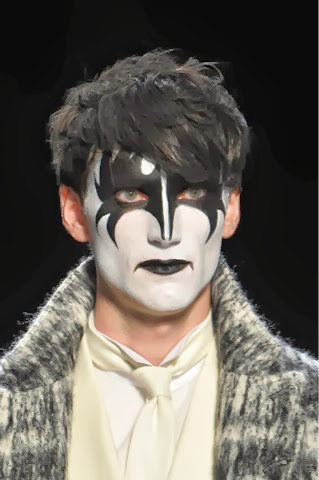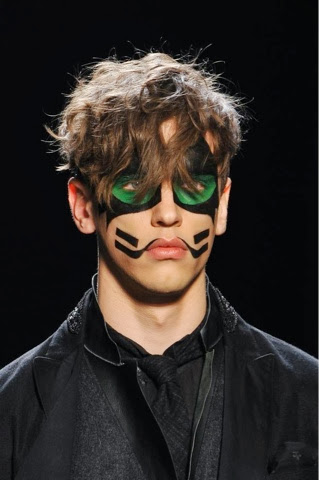There are items that, through the time, not only become iconic but make fashion history.
Diane Von Furstenberg signature wrap-dress is one of these. A dress which is suitable for every kind of body type, that immediately makes us feel classy and ready for every occasion. A dress which has been worn by thousands of women, hundreds of celebrities, that was painted in every kind of colour and experimented all types of patterns.
A dress which turned forty this year.
And It was a huge celebration: in Los Angeles, at LACMA Museum, with an exhibition that, before open to the public from January 11th, was celebrated with a beautiful event. An army of mannequins, all wearing the wrap-dress.
Hundreds of photos and art pieces of these epic forty years. And her, Diane Von Furstenberg in person, to make us all feel at home. Ready to celebrate the dress that changed the rules of fashion.
domingo, 19 de janeiro de 2014
Diane Von Furstenberg Journey Of A Dress Exhibition
sábado, 18 de janeiro de 2014
Fashion meets Art-part 2

Society takes peculiar measures when burdened with high taxes: Some throw tea into the harbor while others take to touring the town on horseback in the nude. The latter, of course, being the method employed by Lady Godiva, the 11th-century noblewomen whose husband would only relinquish the oppressive taxes he imposed on his people if his wife bared all on bareback. (And who could forget the brand of chocolates named in her honor?)
While the legitimacy of this fable has been questioned, it has nonetheless become the subject of countless paintings and sculptures, most notably, John Collier’s 19th-century rendition, ca. 1897. In Collier’s Pre-Raphaelite painting, a modest Lady Godiva sits atop a white horse, her brilliant red hair her only shield against possible voyeurs or a Peeping Tom — the town tailer who, as legend has it, took a peek at the clothes-less Lady Godiva.
In 2000, a fresh-faced Gisele Bündchen was photographed by Walter Chin for Vanity Fair’s January spotlight on the young model. Undoubtedly inspired by the legendary tale, Chin photographed Gisele nude and perched on a white horse for the story, “Unbridled Beauty.”
sexta-feira, 17 de janeiro de 2014
Trend alert! Mini bags!

Mini bags are everywhere I had never written a post about them. If you need to carry lots of things with you everyday you´ll probably hate them but for me big bags are terrible because they weigh heavily :) But someday you just need to carry the mobile, keys and purse and are perfect for that so here’s the inspiration. Let´s pay attention to Alexa, Miroslava, Olivia Palermo and Poppy Delevigne!!

1_ Asos; 2_ Asos; 3_ Rebecca Minkoff; 4_ Rebecca Minkoff; 5_ Asos; 6_ Asos; 7_ Asos; 8_ Topshop; 9_ Gucci; 10_ Rebecca Minkoff; 11_ Topshop; 12_ Marc by Marc Jacobs; 13_ Asos; 14_ Asos; 15_ Rebecca Minkoff; 16_Marc by Marc Jacobs; 17_ Asos; 18_ Tita Madrid; 19_ Lulu Guinness; 20_ Asos




Photos via Vogue, Vanessa Jackman, Stockholm Street Style, Jak & Jil & harper´s Bazaar Korea
domingo, 12 de janeiro de 2014
John Varvatos Fall/Winter 2014
segunda-feira, 6 de janeiro de 2014
100% recycled Denim
100% Recycled Denim Is A Finnish Innovation
:: OUTSAPOP TRASHION DIY fashion :: · 23/12/13 00:46
Did you know that the worlds first 100% recycled denim is a Finnish invention? Neither did I, until I came across Pure Waste Textiles two months ago. I think this is major news for the fashion industry, major, as in B I G. This is a long post, but please read it (and share it) so you understand why I´m so psyched about this.
When I heard of Pure Waste Textiles (made by the same people behind recycle accessory label Costo) and their brand new recycle fabrics, I asked them for an interview. I have to admit I was pretty sceptic about their promises since 100% recycled fabrics are a bit of an unfulfilled dream in the fashion industry. Consumers might think that this product exist already as they have seen denim marked with labels "made with 100% recycled denim", but it has so far meant that the product has some recycled material in it (which is 100% recycled) but there is also normal materials in the mix. This is marked in the wash label, but not many look at it close enough. So I asked PW a bunch of tough questions about their ethics, production methods ect. They answered everything correctly, everything. But I am no engineer. I wanted a professional second opinion, so I contacted estonian eco fashion pioneer and eco fashion PhD Reet Aus. She met with the PW-team to see if they were for real. They passed again and she was very happy to have met them. So I have confirmation. 100% recycled denim exists and it is a Finnish invention.
But why is this so big? For four reasons: the denim and other recycled fabrics that PW produces, require (1) zero water and (2) zero chemicals. When you add that (3) the raw material itself has been harvested from industry cut waste and spinning waste (= recycled) and (4) the labour is also payed well and monitored by the PW-people constantly. When you consider all these facts, you pretty much have the perfect product / fabric by all counts. It is so important that this innovation comes from a fabric supplier as this means that the product can be sold to a number of clothing brands (instead of it being just one clothing brand or one collection) making eco fashion from it. Get my drift? Imagine Levi, Acne, Diesel, H&M.. all using their recycled denim and making t-shirts from their recycled jersey. This is truly the start of a recycle fashion revolution in mass quantities.
Before any of you educated fashionistas yell OVERPRODUCTION, I´ll agree with you. Yes, it would be best not to produce so much clothes in the first place and I seriously hope labels realize the quickest way to make their label greener is to literately skip a couple of collections. If the consumer wants to do their part, best would be to buy quality, take care of their clothes and repair them so they would stay in circulation as long as possible. Cutting down production quantities and focusing on quality instead of quantity is also my first option for a greener fashion industry, but when denims need to be made, PW´s recycle fabrics are a fantastic option. Let´s go deeper into the four reasons why I think PW is so brilliant.
1. THE RAW MATERIAL IS ORIGINALLY WASTE = RECYCLED
Pure Waste uses fabric cut waste from Chinese denim factories and cotton carding waste from spinning factories. In the traditional cutting process leaves off 15% of the original fabric as scraps. This material is grinned and spun to make the recycled denim. Every year 4500 million meters (30 000 feet) of denim fabric is produced so the 15% is roughly 675 million meters of fabric wasted. Using other brands waste to make the fabric, it means that the PW-denim has a non-existent environmental impact on growing cotton which makes it many times better than for example newly grown organic cotton. PW`s jersey comes from factories in India made in the same methods.
2. NO FRESH WATER USED IN PRODUCTION
This is the innovation part right here. PW has done something that no other recycle fabric manufacturer has been able to do before - a zero-water spinning process for denim. We hear a lot of talk about carbon footprint, but I believe it is our water footprint that we should worry about. Air purifies itself quite quickly, but we cannot live with out fresh water daily. All life on land is dependent upon it. We see our water use as we shower, wash our clothes, flush the toilet, water our garden and cook food. But we also use a lot of "invisible water", which is all fresh water imported from other countries, in the consumer product and food we buy. If you ask me, I think the water footprint should be marked in all products so people would realize just how much they consume. One pair of jeans takes 8 000 - 10 000 liters (2600 gallons) of fresh water to make and the denim fabric with in that 3000 liters (800 gallons). When you count that 1,5 meters of fabric is needed to make one pair and every year 3000 million pairs in total to make jeans, you start to understand the amount of fresh water that goes into the making of these products and that would be saved if the production method would be transformed to use less or no water at all. Denim fabric production is mainly focused in countries where fresh water is an agricultural luxury. It should be used in growing food and not making clothes. When buying denim made in far countries, we pay very little to spend their precious natural resources. In the future, when you buy a pair made from PW´s denim, the water footprint will be 800 gallons smaller per pair.
3. NO CHEMICALS USED IN PRODUCTION
Traditional cotton is used to grow with a lot of pesticides. Also the fabric production process takes a lot of chemicals. When production is focused in countries with a poor legislation in environmental control this is a bad combination. PW has taken out chemicals entirely from their fabric production line. This makes a huge positive impact on the factories environmental effect in the nearby land and water areas and also protects the workers. I´m sure many denim companies thought this would be impossible.
4. LABOUR IS ETHICAL AND MONITORED
Most companies just check up on their suppliers factories once or twice a year, but PW has full control of their factories and they have Finnish staff present at all times to make sure things are done their way. Workforce is payed well and the work is safer due to lack of chemical use. Normally I would not be happy about fabric production in China or India, but if you take into count the facts 1-4 it becomes irrelevant where in the world the goods are actually made. PW has fixed al the worst problem areas in production coming from these countries. Logistically it is also smart as the raw cotton waste originates from these countries. This way it does not have to transported far, so the environmental impact of logistics is also smaller. With the labour issues cleared, they also set a positive example to other factories in the area to do the same.
"BUT IT´S JUST REGULAR DENIM RIPPED AND WEAVED INTO A NEW FORM..."
When I wrote about PW to my Finnish blog yesterday, someone commented that they don´t really see this being an improvement as it is "just regular denim ripped and weaved into a new form". I wish things would be this simple or black and white. First of all the terminology is correct. The 15% of cut waste and spinning waste that PW uses as raw material is waste, so the PW-fabric can be called and is recycled. Calling a material waste does not just mean that is needs to be made only from so called post-consumer waste (second hand jeans). Waste is also generated throughout the production phases. Using post-consumer waste as material is extremely difficult as the material is very uneven, contains multiple fibers and is sewn to a form (has to be taken apart manually). All the recycled fashion solutions I´ve seen done from post-consumer waste are only for small production or DIY projects. PW´s materials and products can be mass produced. And by masses I mean tens of thousands, not just in tens or in hundreds. When I came in contact with PW, I wanted to be sure my insight of the brand and product was thought through. This is why I contacted Reet Aus. The woman has a PhD in recycle fashions and ten years of experience from eco clothing production. If she thinks this product is good after an hours chat with PW and follow-up mails, then it must be pretty good. Arguments and discussion are always welcome, but please, make it stick. I rarely praise any product like this, and you can be sure I did my homework on this.
Pure Waste Textiles is also a sustainable company by their business standards. They have a fund which gets a percentage of every meter of denim sold. Not through a campaign or a certain product, like fashion companies usually do this, but permanently and from everything they sell. This money is used to support designers, brands and innovations that help lower consumption, recycling and prolongating usetime. Another example of how a company can support the business, every day.
Check out Costo webstore for this new denim. They carry already a mens shoe, bowties, neckties and an apronmade from recycled denim. What do you think? For me the Christmas present of Finnish design is right here.
Follow Pure Waste Textiles in Facebook // Costo in Facebook.
Images courtesy of Pure Waste.











































